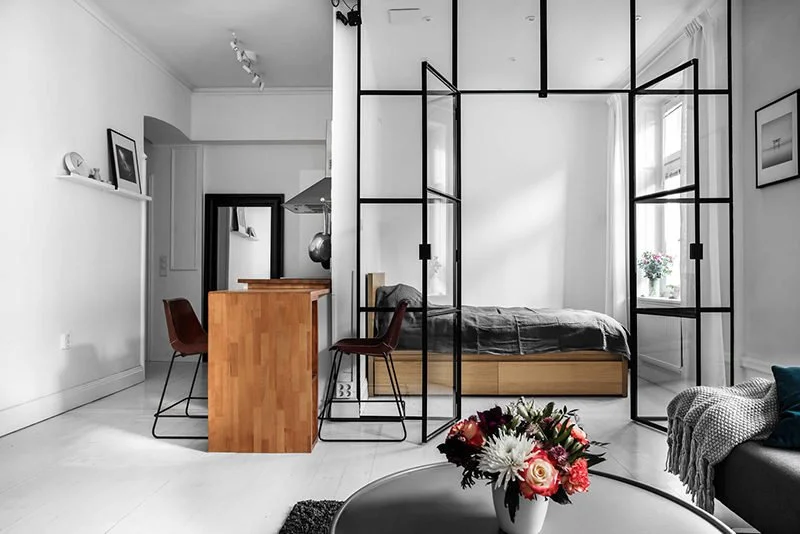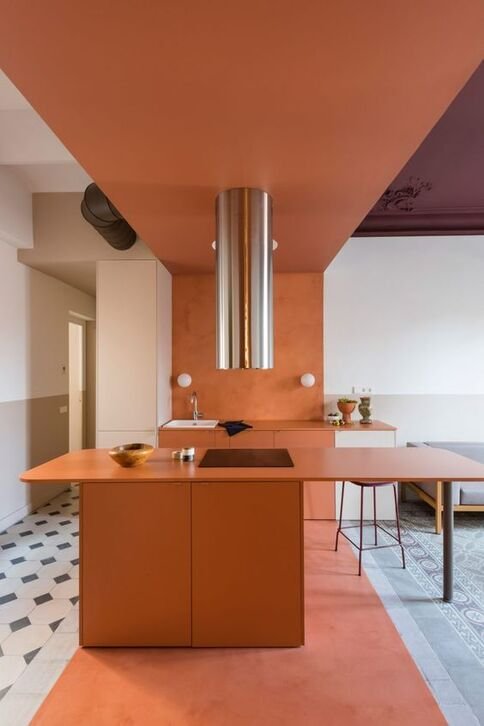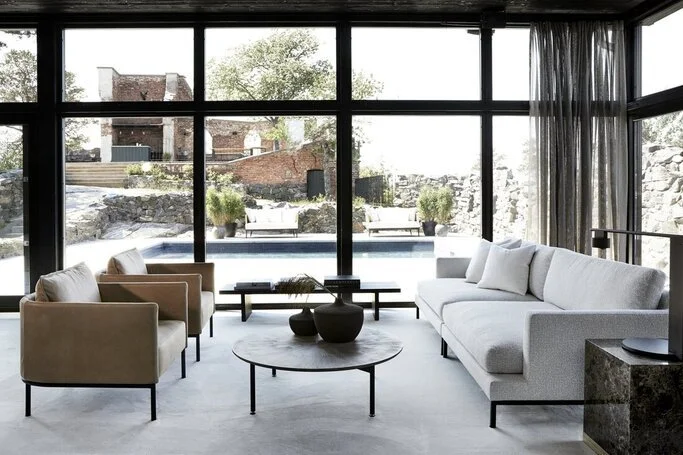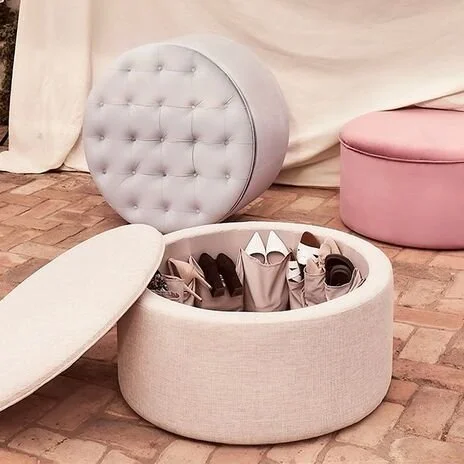Seven Golden Tips for Small Spaces
Studio flat in monochrome palette (image via Pinterest)
Designing a small space, be it a studio flat, a cloakroom or a lavatory can be challenging and sometimes even frustrating. During the lockdown period following the spread of Covid-19, I had the opportunity to watch many interesting Live streaming on Instagram by renowned interior designers. Thanks to two great designers Cinzia from Moretti Interior Design and Nicola from Nicola Burt Interior Design, I received lots of useful tips and inspiration to make the most of our small spaces. I am thrilled to share it with you in this blog post seven golden tips to make your small space feel cozier and bigger!
1. Paint with colour blocks
Terracotta - orange painted colour block applied across the dropped ceiling, splash black, cabinetry and kitchen island (image via Pinterest).
If you have a studio flat, a good way to make it feel bigger is actually to highlight the different zones that are present in the room. To do this you can use the "colour block" technique, which consists of creating a zone with an accent of a different colour from the rest of the room. Cinzia recommended to bring the same colour up to the ceiling as well, in this way the room will feel bigger as it creates an illusion of a longer wall that does not finish, creating a more cohesive room. Furthermore, Cinzia does not recommended to paint the skirting board in white, on the contrary in the same colour as the wall paint. It is also not advised to leave the walls white because it will feel like a white box without character. I would suggest choosing max 5 colours you like for your palette with two-three similar colours in different tones and two colours complementary, creating an interesting contrast. Cinzia and Nicola recommend a paint finish that is not matt, but eggshell or even glossy that can bounce and reflect the natural light to the rest of the room.
2. Use wallpaper with big pattern
Using wallpaper always add a very interesting effect and create a nice focal point in any room. In the case of a small space, it is recommended to use a big pattern quite bold because it will create an optical illusion that the space is bigger. Cinzia described this process as a pretty natural consequence: when we see something big, we think big. A big pattern will make the space perceived as bigger than what it is. It is a psychological reaction that I can totally see happening to me as well every time I look at something bold. Did it happen to you too?
Regarding the wallpaper's type, if you can choose a glittery, shiny finish that again will bounce the light to the rest of the room. Warmer tones work better. A brand that I love for this kind of unique large wallpaper pattern is Glamora. They also have waterproof finishes for any kitchen or bathroom and they can make any wallpaper completely bespoke.
Image: Large banana tree wallpaper pattern in a small bathroom (via Pinterest)
3. Use plenty of mirrors
Mirrors are one of the oldest trick to make a small space feel bigger. What I learned during the Instagram live is that you can apply them also in your kitchen as a splash-back, or on the cabinets to enhance the depth of the kitchen. You can also include them in the back of your bookshelves or in your bedroom on top of your headboard. If you do not wish to have so much reflection, Cinzia suggested an antique mirror finish that will still create the effect of a deeper room, without mirroring too much. For a small bathroom, it is recommended to do the whole wall above the vanity unit, instead of just a circled or squared mirror.
Image: Mirror splash back with antique finish (via Pinterest)
4. Use leggy furniture
Living room furniture with legs for an airy feeling by Slettvoll (www.slettvoll.no)
Something new that I have learned, it is that furniture with legs sitting slightly above the floor level will make the room feel more airy and the furniture will be perceived less solid. It is also a psychological effect, when you see something pretty big sitting directly on the floor, it feels heavier, bigger, reducing the space around and making the room feel smaller. Nicola recommended also to choose furniture with thin armrests or even without if you can. It is perhaps better a modular sofa that can be moved around the room if you need to make more space for example, during a buffet dinner or lunch. A modular sofa can also be easier to bring inside a smaller house/flat with narrow entrance door.
5. Use double-function furniture
Storage is often the issue of smaller spaces. Obviously, it will required a selection of clothing, shoe-ware, and personal items, the so called de-cluttering. Feng-Shui theories stress how important for our well-being and for the good energy flow in the house, to sell or give away things and clothing we don't use and keep only the minimum essential. For what you cannot sell or give away, double-functional furniture will become very handy: be ready to get a pouf with storage for your shoes, a chest of drawers/TV console, folding dining table, etc. Cinzia suggested to select "Mid-Century" style furniture because they were designed to really fit into small spaces. A great advice that I can personally give you is to get a bed with storage by Flou. They are extremely sophisticated, sleek and functional. The bed always take so much space in a room and having a nice storage underneath will help you to keep your stuff cluttered and hidden.
Image: Ottoman with storage by Westwing
6. Incorporate big plants
Large plants make this bedroom feel bigger (image via Pinterest)
Plants cannot be forgotten for the demonstrated beneficial effects on our indoor air and mental health. For the same reasons as the wallpaper pattern, choosing large plants instead of plenty tiny little plants will make us perceive the space bigger. If you would like to know more about how to decorate with indoor plants, you can read this blog post I wrote a while ago. I personally love banana plant, monstera and palms, all very exotic!
7. Leave your floor bare
Bare flooring, without rugs, helps the space feel larger.
Image via Pinterest
A full fitted carpet from wall to wall is not suitable in small spaces, said Cinzia Moretti, as carpets in general tend to adsorb light as they all have a matt finish. It is better to leave your floor bare or use a very minimal and lightweight rug to define the different zones in an open living area. If you would like to use tiles, select a glass tiles or with a gloss finish preferably in a neutral colour. If you prefer instead wooden flooring, I would avoid mahogany that will make the room feel darker and pick a light natural pine or oak wood that suit better a small room or apartment.
In conclusion, if you use the right furniture, materials and decorations together with clever hidden storage space, any small room and apartment can transform in something unique. In a small space you can let go your creativity and experiment with bold colours and big patterns. Mirrors can enlarge the space and create depth, while leggy furniture can make the room feel airy.
I hope you found this blog post and topic very interesting like I did. I believe very often we let ourselves down in front of small spaces and cannot see anymore, the positive aspects. Therefore, I hope after this reading you will feel inspired to experiment with your small room or studio apartment. I am incredibly grateful to Cinzia from Moretti Interior Design and Nicola from Nicola Burt Interior Design, for all their useful tips that motivated me to write this article. If you would like to know more about their interior design studios, please go ahead to:
Nicola Burt Interior Design: www.nicolaburtinteriordesign.com
Moretti Interior Design: www.morettiinteriordesign.com
I will definitely use these seven golden tips for our future apartment that is not so big (47sqm), although, I am pretty sure that with these simple rules we will feel it bigger and airy. If you would like to see some incredible before & after pictures, do not miss to follow my Instagram profile where I am @interiorsbyambrosi and future articles on this blog.
Thank you for reading!









